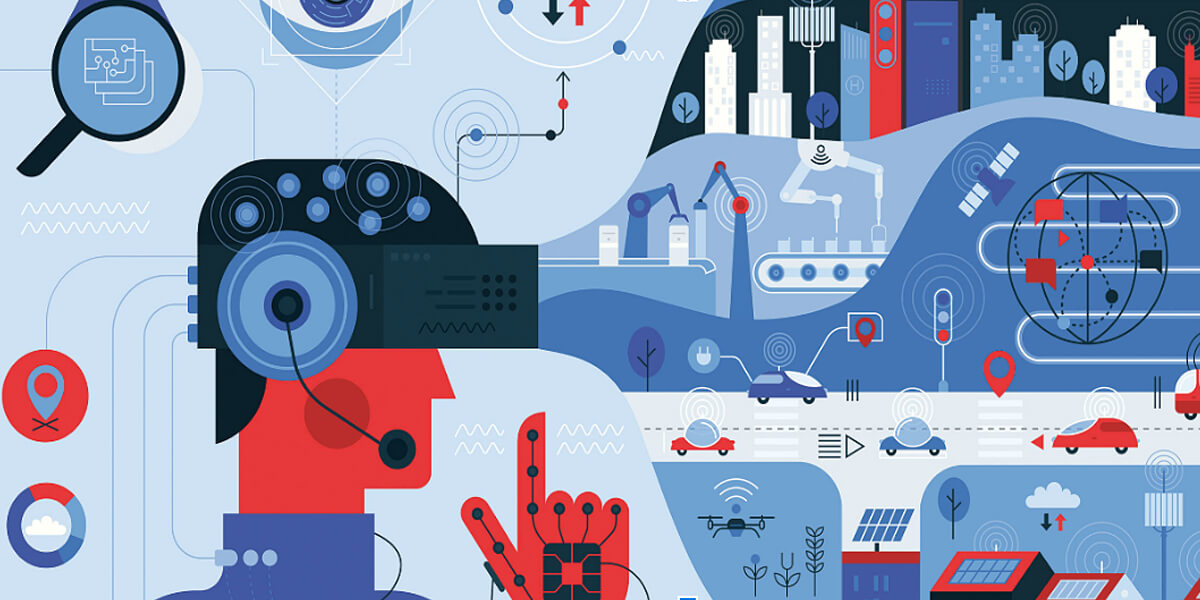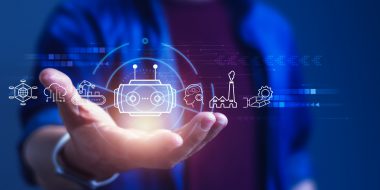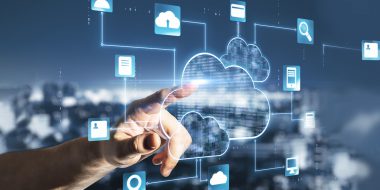“One of the leading Fortune 500 manufacturing enterprises, successfully tackled supply chain challenges by implementing a Hyperconnected Ecosystem. By integrating smart sensors and Internet of Things (IoT) devices, they gained real-time visibility into inventory, production, and logistics data. With advanced analytics, the company made data-driven decisions, optimizing inventory levels, production schedules, and predictive maintenance. Collaborating with suppliers and logistics partners through the ecosystem streamlined operations, ensuring timely sourcing and delivery of materials. The ecosystem’s real-time tracking and tracing capabilities improved distribution efficiency, leading to enhanced productivity, cost savings, and a competitive advantage for the company, making it a shining example of successful digital transformation in the enterprise sector.”
– Swati Nigam
Hyperconnectivity is becoming the standard in today’s fast changing technological environment thanks to innovations like 5G, programmable networks, edge computing, and cloud technologies. Beyond physical systems, this interconnection permeates social networks and a variety of applications, enabling advancements including autonomous ambulances, smart factories and others. The amount of data being produced is growing dramatically as technology becomes smarter and faster, which forces businesses and telcos to work with partners to investigate novel possibilities and create early use cases. Business leaders have a rare opportunity to embrace hyperconnectivity, create early minimum viable products (MVPs) via partnerships, and remain ahead of the innovation curve in this hyperconnected future, thanks to this complex, evolving ecosystem.
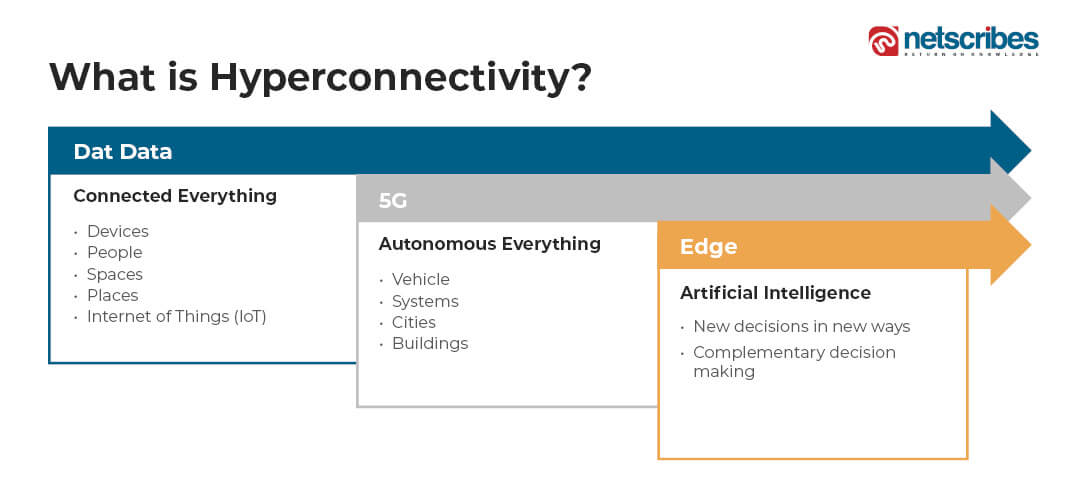
A hyperconnected ecosystem denotes the integration of devices, systems, and technologies to facilitate seamless communication and data interchange. This interconnectedness empowers enterprises to optimize their operations, elevate customer experiences, and attain a competitive advantage in the market. Hyperconnected ecosystems leverage the power of hyperscale computing, the ability to scale computing resources on-demand to meet the demands of data-intensive applications.
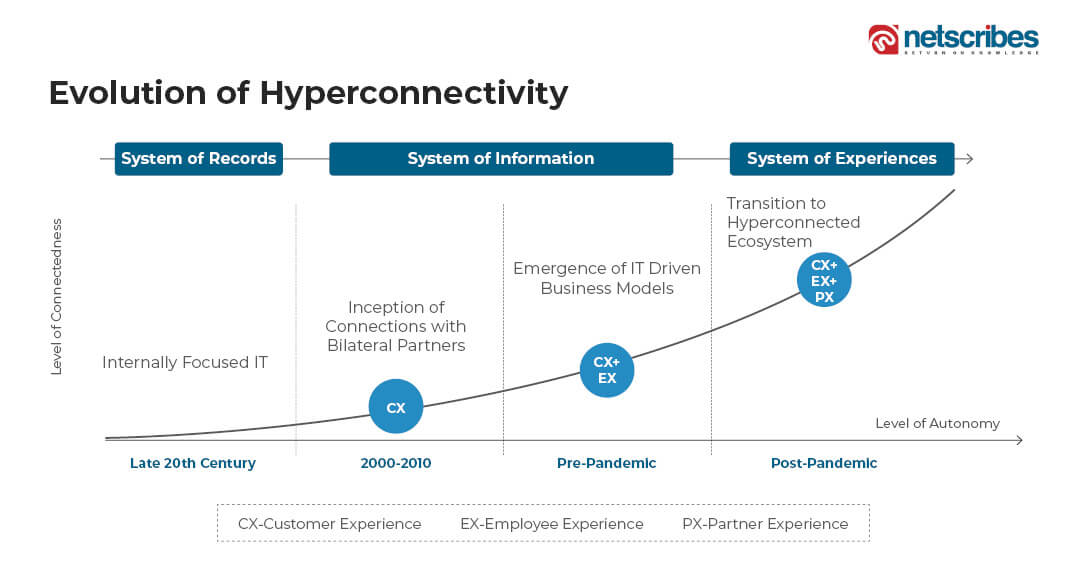
During the late 20th century: The level of autonomy was nearly zero. A majority of organizations in this period operated in silos, concentrating on basic enterprise resource planning (ERP) systems and the focus was only on delivering services requested through the system of records.
Between 2000 and 2010: The level of autonomy within companies started lying in 0-25%. The emergence of new business scenarios such as Public Cloud, Digital Marketplaces, Private Cloud, and robotic process automation (RPA) occurred, and firms began to have partners to boost CX index through a system of information.
Pre–Pandemic: The level of autonomy within companies started heading up to 75%. The introduction of productivity-driven technologies such as Intelligent Automation, Machine Learning (ML), and Open Source occurred, and firms began to have partners to boost CX and EX through a system of information.
Post–Pandemic: The level of autonomy within companies started reaching up to 95%. The emphasis has switched to more efficient connection shifts such as Metaverse, Generative Artificial Intelligence (AI), B2B2C, As-a-service models, and Phygital to improve CX, EX, and PX to create a system of experiences.
Related reading: How data-driven digital transformation looks like in the real world
Hyperconnected ecosystems for enterprises
The COVID-19 pandemic accelerated business digitalization, driving higher demand for hyperconnected ecosystems. At the core of business innovation lies enhanced connectivity, providing enterprises with seamless access to fluidic connectivity and flexible transport choices that leverage smart wide area network (WAN) solutions across edge and global networks. This empowers them to deliver improved digital experiences while gaining enhanced business agility. Hyperconnected ecosystems present a plethora of advantages for enterprises, facilitating operational transformation and fostering innovation. Some of these benefits include:
Enhanced communication and collaboration
Hyperconnected ecosystem enhances connectivity among employees, partners, and customers, fostering real-time communication and data sharing that drives collaboration, efficiency, and productivity. The financial industry is experiencing significant transformation due to hyperconnectivity, enabling banks to offer diverse services through mobile banking, virtual agents, and data analytics. Banks are building customer-centric ecosystems and integrating financial services into popular consumer platforms, resulting in a more convenient and personalized customer experience while also expanding their market reach.
Data-driven decision making
Hyperconnectivity empowers enterprises with vast data access from multiple sources. Utilizing advanced analytics and ML, enterprises gain valuable insights for informed decision-making. Hyperconnectivity means always connected, across all channels, to exchange not only data but also intelligence. Representing the future of business, hyperconnected ecosystems enable enhanced customer experience, cost reduction, and increased innovation.
Innovation and agility
It drives innovation through rapid ideas and knowledge exchange. Collaboration with external stakeholders expedites product development and adaptation to market demands. For instance, the European Tour Group partnered with Tata Communications to create a contactless TV production environment, reducing personnel by over 30%. They also work with Alibaba to support ESG initiatives and enable hyperconnected ecosystems for sporting events. Similarly, Tata Communications empowers Formula 1 to deliver a seamless and immersive global fan experience while centralizing live data analysis and video production to promote sustainable practices and reduce travel.
Technological implications of a hyperconnected ecosystem
The combination of 5G and software-defined WAN (SD-WAN) has the potential to completely transform the entire networking landscape for next generation enterprises. SD-WAN offers low-cost, reliable management of complex and diverse networks, while 5G provides ultra-high-speed connectivity. Together, they can enable a real impact in enterprise branch networking and interconnecting data, systems, applications, clouds, and ‘things’ at the edge.
- Low-cost, reliable management of complex and diverse networks: SD-WAN can help businesses to reduce the cost of their WANs by enabling them to use a variety of different transport links, such as multiprotocol Label Switching (MPLS), internet, and 4G/ long term evolution (LTE). SD-WAN can also help to improve the reliability of networks by providing redundancy and load balancing.
- Ultra-high-speed connectivity: 5G can provide businesses with ultra-high-speed connectivity, which is essential for applications that require low latency, such as real-time video streaming and virtual reality.
- The ability to connect devices at the edge: 5G can help businesses to connect devices at the edge, such as sensors and actuators. This can help businesses collect data and act in real time.
Hyperconnected ecosystems have transformative applications to enable technological advancements across various industries. Some of the key technical applications of hyperconnectivity are discussed as follows:
- IoT and industrial automation: Hyperconnectivity enables smart manufacturing, supply chain optimization, predictive maintenance, and asset tracking. These applications result in improved operational efficiency and cost savings.
- Cloud computing and big data analytics: Hyperconnected ecosystems leverage scalable infrastructure for managing large volumes of data. Real-time data processing and analysis enable personalized customer experiences and targeted marketing.
- AI and ML: Through hyperconnected ecosystems, enterprises can automate decision making and optimize processes. Intelligent virtual assistants, such as chatbots, enhance customer service and provide personalized recommendations.
Challenges and considerations for enterprises
While a hyperconnected ecosystem offers significant benefits, enterprises must address few challenges and considerations, such as:
- Security and privacy concerns: Interconnected systems require enterprises to prioritize data protection and regulatory compliance to mitigate data breaches and cyber threats.
- Integration and interoperability: Standardizing and normalizing data, as well as integrating legacy systems, are the challenges due to compatibility issues between different systems and platforms.
- Organizational change and cultural shift: Enterprises must adapt to new ways of working and foster collaboration across departments and stakeholders.
Conclusion
Hyperconnected ecosystems play a vital role in business digital transformation fostering enhanced communication and collaboration, data-driven decision making, and innovation and agility. This transformation driven by hyperconnectivity is revolutionizing enterprises, ushering in novel business models, services, and consumer experiences. The advent of 5G and hyperscale computing is poised to expedite this evolution further. Nonetheless, enterprises must address security, privacy, and sustainability challenges to fully leverage the advantages of hyperconnectivity. Adaptation and innovation in this hyperconnected future will be key for enterprises to flourish.
Netscribes offers comprehensive insights to leaders in the hyperconnected ecosystem market space, covering customer intelligence, competitive landscape, partner and vendor ecosystem, market and technology trends, and more. These valuable inputs aid in defining effective sales and marketing strategies, facilitating leadership meetings, workshops, conferences, and other events and campaigns. To know how we can help your business uncover your true digital transformation potential, contact us.
Based on insights by Swati Nigam, Manager, Technology Media & Telecom team

